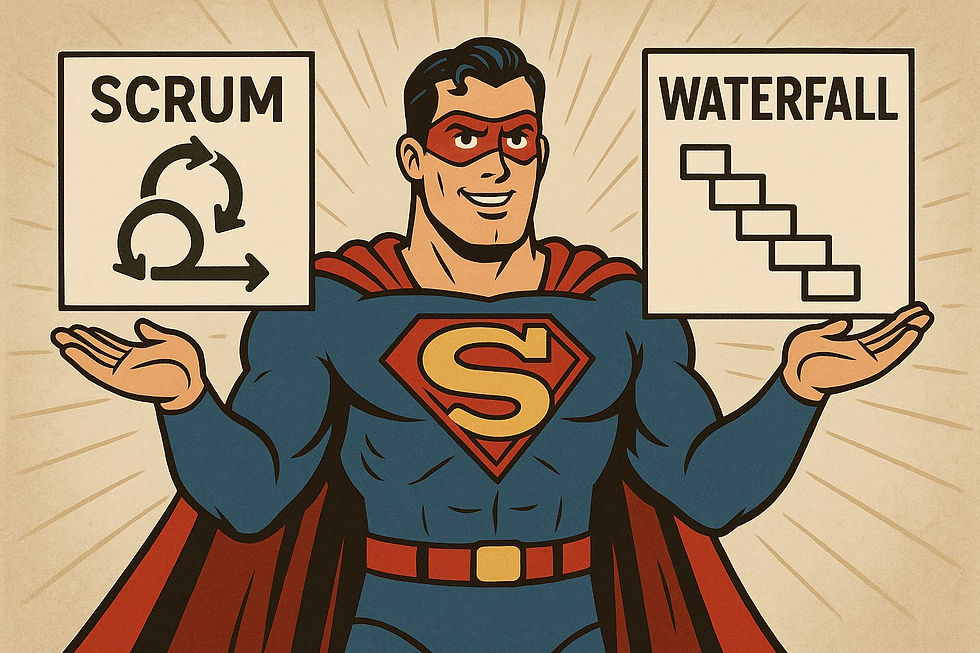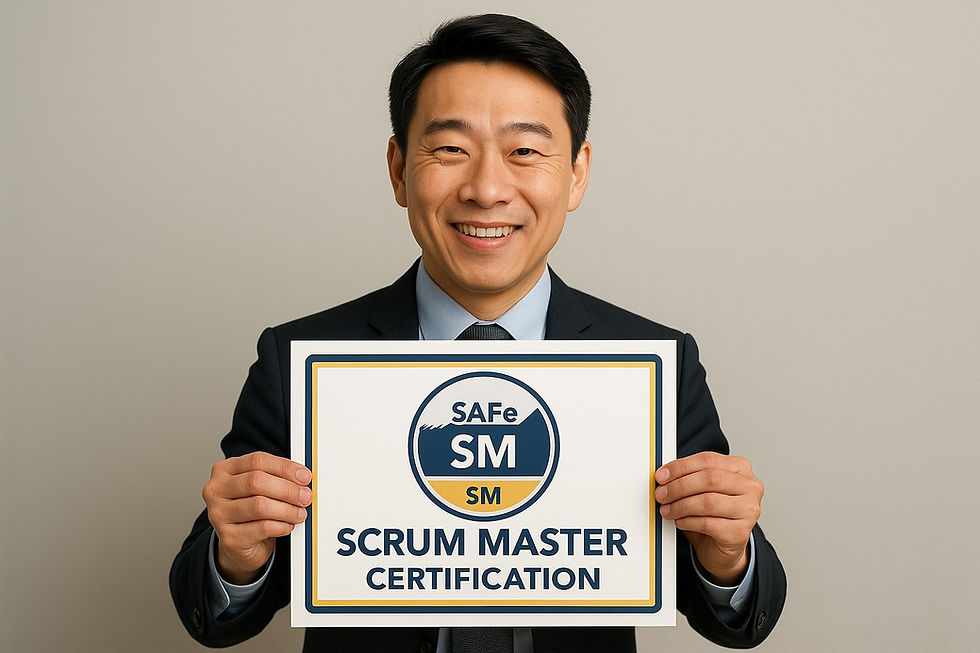Scrum Glossary: The Complete Guide
- Michelle M

- Aug 25
- 6 min read
Scrum is one of the most widely used agile frameworks, empowering teams to deliver value iteratively and collaboratively. To fully understand Scrum, it helps to know the essential terms, roles, and artifacts that form its foundation. This Scrum glossary serves as a comprehensive guide, offering clear explanations of over 100 key concepts that every Scrum practitioner, project manager, or agile team member should know.

1. Scrum
A lightweight agile framework designed to help teams develop, deliver, and sustain complex products through adaptive practices.
2. Agile
A mindset and set of principles focused on iterative development, collaboration, and responding to change.
3. Sprint
A fixed-length iteration, usually 1–4 weeks, during which a team produces a potentially shippable product increment.
4. Product Backlog
An ordered list of work items representing everything needed in the product, owned by the Product Owner.
5. Sprint Backlog
A list of items selected from the Product Backlog that the Development Team commits to delivering in a Sprint.
6. Increment
The sum of all completed backlog items within a Sprint that meets the Definition of Done.
7. Product Owner
The role responsible for maximizing product value and managing the Product Backlog.
8. Scrum Master
A servant-leader role ensuring that Scrum is understood and enacted correctly.
9. Development Team
A cross-functional group responsible for delivering increments during each Sprint.
10. Daily Scrum
A short, daily meeting where the Development Team synchronizes work and plans for the next 24 hours.
11. Sprint Planning
A time-boxed event at the start of each Sprint where the team plans what will be delivered and how.
12. Sprint Review
A meeting held at the end of the Sprint to inspect the Increment and adapt the Product Backlog.
13. Sprint Retrospective
A meeting at the end of each Sprint where the team reflects and identifies improvements.
14. User Story
A short, simple description of functionality from the perspective of the user.
15. Acceptance Criteria
Conditions that must be met for a backlog item to be accepted as complete.
16. Definition of Done (DoD)
A shared agreement on what it means for work to be complete and ready for release.
17. Time-boxing
Allocating a fixed amount of time to an event or activity in Scrum.
18. Velocity
The measure of work completed in a Sprint, typically expressed in story points.
19. Burndown Chart
A visual representation of remaining work in a Sprint or project over time.
20. Burnup Chart
A visual chart showing completed work versus the total scope.
21. Scrum Guide
The official guide created by Jeff Sutherland and Ken Schwaber describing the Scrum framework.
22. Product Increment
The latest version of the product built during a Sprint, ready for use if desired.
23. Story Points
A relative unit of measure for estimating the effort required to complete a backlog item.
24. Relative Estimation
A method of comparing tasks against each other rather than assigning absolute hours.
25. Planning Poker
A collaborative estimation game where team members assign story points to backlog items.
26. Product Vision
The long-term goal or direction for the product.
27. Product Roadmap
A high-level visual summary mapping the product vision and major milestones.
28. Release Planning
Organizing when and how product features will be delivered to users.
29. Cross-functional Team
A team with all the skills needed to deliver product increments without external dependencies.
30. Self-organizing Team
A group that manages its own work and responsibilities without external micromanagement.
31. Empiricism
The foundation of Scrum, relying on transparency, inspection, and adaptation.
32. Transparency
Making processes, work, and progress visible to all stakeholders.
33. Inspection
Regularly checking progress toward goals to detect variances.
34. Adaptation
Adjusting plans and approaches based on insights gained from inspection.
35. Servant Leadership
The philosophy embraced by Scrum Masters to serve the team while enabling growth and success.
36. Agile Manifesto
A set of guiding principles for agile development created in 2001.
37. Backlog Refinement
The ongoing process of reviewing, clarifying, and prioritizing backlog items.
38. Stakeholders
People or groups who have an interest in the outcome of the product.
39. Epic
A large user story that needs to be broken down into smaller items.
40. Theme
A collection of related epics or stories that contribute to a larger objective.
41. Release Burnup
A chart tracking progress toward release goals over time.
42. Spike
A time-boxed research task to reduce uncertainty or gather knowledge.
43. Technical Debt
The implied cost of rework caused by choosing quick solutions over long-term quality.
44. Scrum of Scrums
A scaled coordination meeting for multiple Scrum teams working on the same product.
45. Nexus
A scaling framework that extends Scrum to large initiatives with multiple teams.
46. SAFe (Scaled Agile Framework)
A framework for scaling agile across enterprises.
47. LeSS (Large-Scale Scrum)
A framework for scaling Scrum to multiple teams.
48. Incremental Delivery
Delivering small pieces of functionality regularly rather than one large release.
49. Continuous Integration
The practice of integrating code frequently and testing automatically.
50. Continuous Delivery
The capability of releasing product increments at any time.
51. Continuous Deployment
Automatically deploying every change that passes automated testing.
52. Product Goal
The long-term objective of the Scrum team.
53. Sprint Goal
A short-term objective that provides focus during the Sprint.
54. Task Board
A visual board showing tasks in progress, often divided into columns like “To Do,” “In Progress,” and “Done.”
55. Kanban
A visual workflow method often used alongside Scrum to improve flow.
56. Flow Metrics
Measurements like cycle time and throughput used to optimize delivery.
57. Cycle Time
The amount of time it takes to complete a work item from start to finish.
58. Lead Time
The time from a request being made until it is delivered.
59. Value Stream
The steps required to deliver value to a customer.
60. Agile Coach
A professional guiding teams and organizations in agile practices.
61. Roadmap Alignment
Ensuring Scrum team outputs align with broader business objectives.
62. Agile Release Train
A SAFe term for long-lived teams delivering value together.
63. Impediment
Anything blocking the team from delivering work.
64. Escaped Defects
Bugs found after the product has been released.
65. Product Discovery
Exploring user needs and potential solutions before building.
66. Minimum Viable Product (MVP)
The simplest version of a product that can be released to validate assumptions.
67. Incremental Learning
Learning from feedback gained in small iterations.
68. Sprint Capacity
The team’s total available work time in a Sprint.
69. Pair Programming
Two developers working together on the same code simultaneously.
70. T-Shaped Skills
Having deep expertise in one area and broad knowledge across others.
71. Agile Maturity
The degree to which an organization adopts agile principles.
72. Agile Transformation
The organizational shift toward adopting agile practices at scale.
73. Done Increment
A deliverable that meets all Definition of Done criteria.
74. Emergent Design
Allowing software design to evolve iteratively.
75. Agile Metrics
Measures that evaluate team performance and delivery.
76. Scrum Anti-Patterns
Behaviors that go against Scrum principles, such as micromanagement.
77. Product Backlog Item (PBI)
An individual item of work in the Product Backlog.
78. Time-to-Market
The time it takes to deliver a product or feature to users.
79. Refinement Session
A meeting dedicated to clarifying and sizing backlog items.
80. Agile Contracts
Agreements structured to encourage collaboration and flexibility.
81. Agile Estimation
Techniques for sizing backlog items, like story points or T-shirt sizing.
82. T-shirt Sizing
Relative estimation using sizes (S, M, L, XL) instead of numbers.
83. Retrospective Action Item
A concrete step identified in retrospectives for improvement.
84. Working Agreement
Team-defined rules for collaboration.
85. Servant Leadership Mindset
A leadership style focused on empowering others rather than commanding.
86. Empirical Process Control
Making decisions based on what is known and observed.
87. Agile Value Delivery
Maximizing customer satisfaction by delivering frequently.
88. Scrum Ceremonies
Another term for Scrum events such as Sprint Planning and Retrospectives.
89. Information Radiator
A visible display of important team information like burndown charts.
90. Agile Governance
Oversight structures that support agile delivery.
91. Scrum Scaling
Extending Scrum principles to larger organizations.
92. Agile Portfolio Management
Managing multiple initiatives in line with business goals.
93. Agile Program Management
Coordinating multiple related projects using agile.
94. DevOps
A cultural and technical approach integrating development and operations.
95. Agile Ceremonies
Structured events that drive alignment and collaboration.
96. Sprint Commitment
The work the team believes it can accomplish in a Sprint.
97. Estimation Poker
Another name for Planning Poker.
98. Grooming
An older term for backlog refinement.
99. Agile Release Planning
Organizing multiple Sprints into a release cycle.
100. Value Delivery Framework
An approach for ensuring that teams focus on customer outcomes, not just outputs.
Conclusion - Scrum Glossary
Scrum is more than just a framework it’s a way of thinking, working, and delivering value. By mastering the terminology outlined in this Scrum glossary, individuals and teams can better align on goals, communicate clearly, and execute effectively in complex projects. Whether you’re a Scrum beginner or an experienced practitioner, revisiting these terms ensures a stronger understanding of agile principles in action.
Professional Project Manager Templates are available here
Key Learning Resources can be found here:
Hashtags
#Scrum #Agile #ScrumGlossary #AgileGlossary #ScrumFramework #AgileCoach #ScrumMaster #ProductOwner #ScrumEvents #ScrumRoles #AgileProjectManagement #ScrumTeam #AgileDevelopment #ScrumCeremonies #AgileTransformation



































